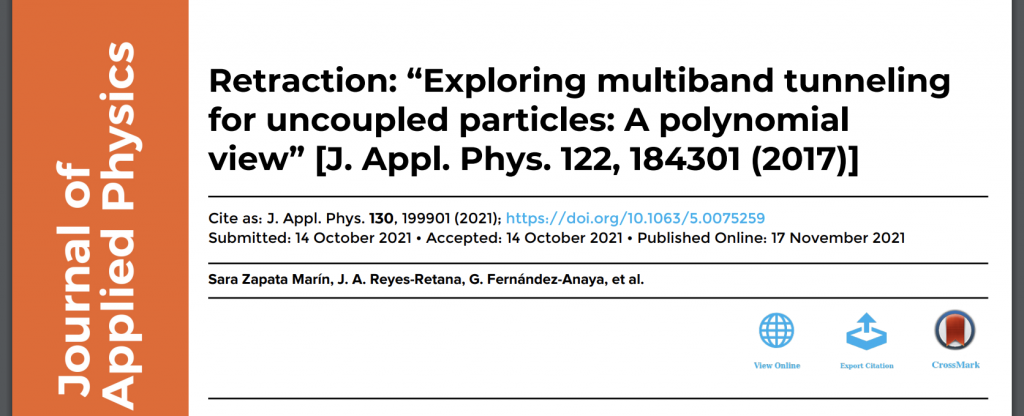
A physics journal has retracted a 2017 paper after learning that the authors had tried to pass off the ideas of others as their own.
Normally, we’d just call that a case of plagiarism and move on. But in this case, the charge goes a bit deeper – less cribbing a few lines of the Principia and more claiming to have discovered gravity.
“Exploring multiband tunneling for uncoupled particles: A polynomial view,” was written by a group of a half-dozen researchers in Mexico City, Uruguay and Cuba, where senior author Leo Diago-Cisneros sits on the faculty of the University of Havana.
The paper, which appeared in the Journal of Applied Physics, purported to describe:
“[a] new approach based on a polynomial-scattering formalism … for n-cell multi-channel layered heterostructures. The model reproduces the majority of considered experimental measurements, better than prior theoretical results.”
Except that the new approach wasn’t so new after all. Much of it was rooted in the work of Pedro Pereyra, a condensed matter physicist at the Metropolitan Autonomous University in Mexico City.
Here’s how the retraction notice puts things:
The authors have agreed to retract the referenced paper1 due to significant overlap with other publications.2–5 The authors recognized that they have misrepresented a published theoretical model as if they had found it. The theoretical treatment of multiband multicomponent systems presented in Sec. II was reproduced from a preprint,2 which was later published.3 The non-commutative polynomial recurrence relation and the closed formulas for tunneling time through superlattices were also reproduced from previously published material.4,5
The authors deeply regret their actions and sincerely apologize. They recognize that their misrepresentation does not comply with the ethical standards of AIP Publishing and of Journal of Applied Physics.
The researcher did cite the publication from which the authors lifted their model — this 2002 article in Physical Review B by Pereyra and Edith Castillo, along with another of the articles by Pereyra indicated in the retraction notice and several other papers by him.
The now-retracted paper has only been cited once, by another article involving Diago-Cisneros — who didn’t respond to a request for comment.
Andre Anders, the editor-in-chief of the journal, told us:
We were first notified of a potential issue in July, 2021. Prof. Pedro Pereyra emailed our journal website’s helpdesk with allegations that were then forwarded to the Editorial team. …[T]he authors did cite the published version (Ref. 3 in the retraction) of the preprint (Ref. 2). However …it did not fully credit the original authors. The theoretical treatment of multiband multicomponent systems was reproduced from the preprint. The authors misrepresented the model as if they had discovered it, despite the reference.
Anders added that:
At this time, I am not aware of repercussions for the group.
Like Retraction Watch? You can make a one-time tax-deductible contribution by PayPal or by Square, or a monthly tax-deductible donation by Paypal to support our work, follow us on Twitter, like us on Facebook, add us to your RSS reader, or subscribe to our daily digest. If you find a retraction that’s not in our database, you can let us know here. For comments or feedback, email us at [email protected].